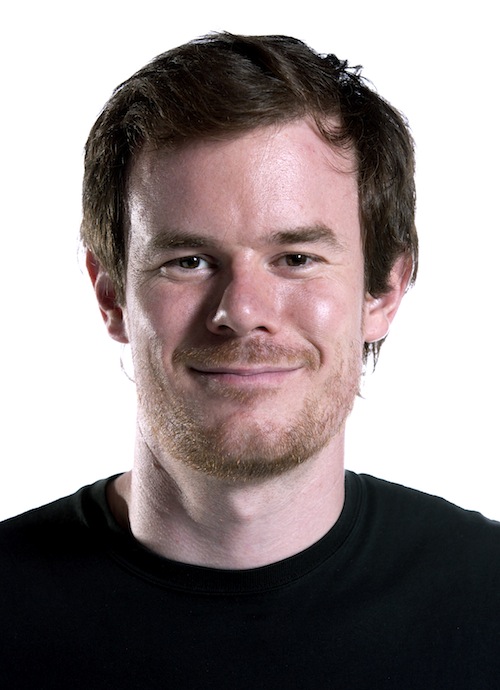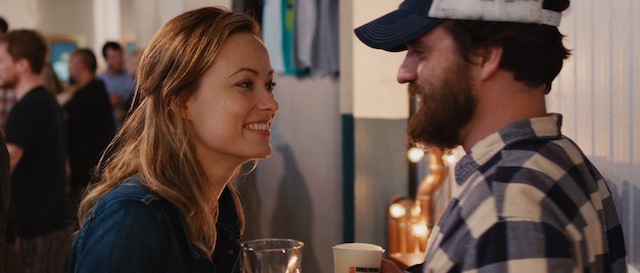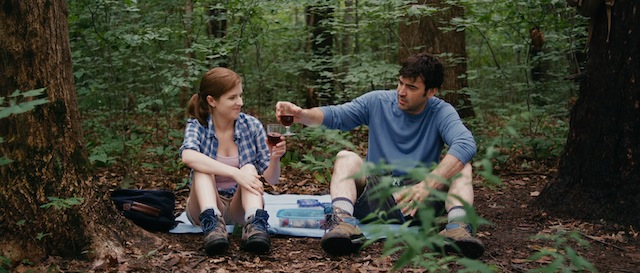CHICAGO – Patrick McDonald of HollywoodChicago.com appears on “The Morning Mess” with Dan Baker on WBGR-FM (Monroe, Wisconsin) on March 21st, 2024, reviewing the new streaming series “Manhunt” – based on the bestseller by James L. Swanson – currently streaming on Apple TV+.
Interview: Joe Swanberg Dares to Cross the Line in ‘Drinking Buddies’
CHICAGO – It takes a special sort of filmmaker to hit it big without compromising any artistic principles. This month marks a career high for Chicago’s own DIY trail-blazer, Joe Swanberg, whose microbudget gems have influenced everyone from Lynn Shelton (“Touchy Feely”) to Lena Dunham (“Girls”). On Friday, August 23rd, two of Joe’s buzzed-about pictures will receive a limited theatrical release.
One is Ti West’s darkly satirical horror lark, “You’re Next,” which is currently being advertised at every creepy subway station in the Windy City (Swanberg plays an amusingly hatable character with a smug disregard for indie flicks). The other film is Swanberg’s 15th feature effort, “Drinking Buddies,” featuring an all-star cast, cinematography from a Cannes prize-winner (“Beasts of the Southern Wild” DP Ben Richardson) and an actual budget. Yet Swanberg’s improvisational style and observant eye for naturalistic nuance remains entirely intact. Olivia Wilde is sublime as an easygoing Chicagoan who engages in a flirtatious friendship with her buddy (Jake Johnson) at a brewery, despite the fact that they both have significant others (Ron Livingston and Anna Kendrick, respectively). Swanberg sat down with Hollywood Chicago at Revolution Brewing to chat about his evolution as a filmmaker, his embracement of static shots and why he allowed his characters to “cross the line.”
HollywoodChicago.com: You recently told “The New York Times” that you consider “Drinking Buddies” to be your first feature and that you regard your last decade of work as “practice.” Care to elaborate?
Joe Swanberg: It’s all been about experimentation. I can’t get behind this “first feature” culture that we live in, or “first book” or “first album” or any of that stuff. We really value a young person’s “first statement.” Filmmakers whose work I’ve always admired are people who make a lot of stuff, and their stuff has gotten better and more innovating and more interesting the older they’ve gotten. I would like to also say, ten years from now, that I’ve made my first feature and that the last 20 years was practice. I plan to do this for a really long time and I don’t plan to do the same thing over and over again.
I call “Drinking Buddies” my first feature because it’s the first “movie” I’ve made. It’s the first film I’ve done since film school where I got a crew together and wrote a script—it didn’t have dialogue, but I wrote it—and we made a movie that’s meant to be a movie. That’s not to take away from any of the other things I’ve made. I care about all of them, and on certain ones, we got a lot of things right, and I’m very proud of those movies. But I could’ve very easily been in a grad program and made those movies too, and they would’ve been considered student work. It’s all about contextualization. I’m 31 years old. “Drinking Buddies” could easily be a first feature. It’s sort of when a lot of people make their first movies. But it’s also a playful statement. The film is very much a continuation of what I’ve been doing, it’s not like a complete left turn or change of pace.

Joe Swanberg, director of Drinking Buddies.
Photo credit: Magnolia Pictures
HollywoodChicago.com: With having your responsibilities limited to direction, rather than having to worry about tasks such as catering, were you able to achieve things on this set that you didn’t have time for in the past?
Swanberg: I did. There’s a broader attention to detail that I was able to pay on “Drinking Buddies” that I haven’t been able to before. On the other movies, I could certainly move things around that were in the background of shots, but I need access to whatever I can get. If I have a character who lives in an apartment in Chicago, I don’t have a locations person who gets to scout 15 apartments to pick the perfect one. I just have to call some friends and see who doesn’t mind me being in their space for a couple days. The accumulation of being able to be specific about everything in the movie results in it being a movie that feels bigger, and results in the sort of movie that people are more used to seeing. The trade-off is flexibility. I think I’ll be bouncing back between projects with the scope of “Drinking Buddies” and much smaller stuff.
HollywoodChicago.com: In the early days of your career, you said that you weren’t interested in working with name actors or veterans of the craft. How have your views towards actors changed?
Swanberg: The actors in “Drinking Buddies” have already built a rapport with audiences. They each have their own body of work to draw from, and there’s something exciting about all of us putting our audiences together. It’s very different from making a film with unknown actors where the audience is just my audience. People who love Olivia are also going to get to see Anna work and see me work, and people who love Anna are going to see Jake work and Ron work. It’s this idea of cross-promotion that’s a different kind of thing for me, as well as cross-pollination of ideas. I learned things from all four [main actors] that influenced and helped the movie. They also happen to be great actors. It’s a different experience to be onset and watch great actors work. I’ve felt that before working with people like Jane Adams, Greta Gerwig, Amy Seimetz and Kate Sheil. I’ve worked with great actors before and have had the pleasure of watching them work, but it’s a different experience to work with great actors who already have their own relationship with the audience and who are going to be champions of the film. They’re going to get it out to people.
HollywoodChicago.com: Did you have to alter your directing approach working this cast?
Swanberg: It felt similar. If things were different, I wasn’t aware of it. The production aspects were different. We were on a tighter timeline. I was obviously collaborating with a lot more people, but when it came to shooting the scenes and working with the actors, it felt the same as it always has.
HollywoodChicago.com: What in particular made this experience freeing to you?
Swanberg: Having great producers was a big part of it. I was working with a great cinematographer, great art department, great wardrobe. Having every detail of the film be carefully curated by people who were passionate about those aspects meant that I didn’t have to be passionate about them. I don’t mean for that to sound negative like I wasn’t passionate about what people were wearing. I knew I was in good hands, so it liberated me to focus on the things that I wanted to focus on. It was lovely. I woke up excited every day to go to work. It wasn’t like, “I’m going to be dead tired by the end of it, and the effort that we’re about to put forth is going to grind me slowly into the ground.” I woke up and knew that I was about to work with talented people who are all doing a really great job. I just need to do a good job on my own little part of this.

Olivia Wilde and Jake Johnson star in Joe Swanberg’s Drinking Buddies.
Photo credit: Magnolia Pictures
HollywoodChicago.com: Your characters in past films have often been criticized about not “getting serious” in life. Do you see any correlation between that and your own aspiration to get serious as an artist?
Swanberg: A little bit. It’s interesting to be a twentysomething person in America because we’re allowed to have this extended adolescence that most people don’t have the luxury of having. I’ve been trying to document that and the characters in my films are usually at a very different place than I’m at in my own life. “Kissing on the Mouth” and “LOL” are the two films I made where the characters were at the exact same place that I was. But on “Hannah Takes the Stairs,” I was making a film about a woman out of college, fumbling through relationships and her career, while in my own personal life, I was engaged and ready to get married. I was in a different place. By the time I did “Drinking Buddies,” I was five years into my marriage and I had a child.
The people who dislike these movies sense that they were made by people who are just filming their friends, and that there’s no critical distance, just navel-gazing. The fact is, for me, they haven’t been that at all. They’ve very much been critically distanced and it’s an attempt to accurately portray the things that I’m seeing people my age go through, even if they’re not at all similar to what I’m personally going through. [“Navel-gazing”] is the easiest dismissal to make of the work. I get it, and I certainly don’t expect that everyone will like these movies. But it’s annoying to hear the claim that no thought was put into these movies, and that I’m just picking up the camera and pointing it at a friend.
HollywoodChicago.com: How did you land on Ron Livingston for the role of Wilde’s boyfriend? I felt like he was a particularly inspired choice.
Swanberg: I Skyped with him a couple times and just got along really well with him. I could tell right away that he was incredibly smart and really sensitive. We had an easy rapport and a good time talking to each other. That’s what I’m looking for in the people I’m working with: a complex, interesting life outside of the movies. I could tell Ron was the sort of guy who had read a lot of books and was just interested in things. I didn’t sense a lot of self-importance or egotistical narcissism or anything like that. This is a guy who acts for a living but who’s intelligent and interested in the world around him. After I offered him the role, it was really cool to e-mail back and forth with him in the days leading up to the shoot. I told him what I was thinking about the character, and he would come back to me with a lot of his own thoughts. It was a really great working process. He’s someone I’d like to make a lot of movies with.
HollywoodChicago.com: One of my favorite scenes in the film was his uneasily intimate moment with Anna Kendrick on a picnic blanket. Was that scene always meant to take place in a single static shot?
Swanberg: Yeah, it definitely was. It was one of those shots that I had always pictured as a static master shot. As in a lot of [production days] on “Drinking Buddies,” it was so much fun to watch that unfold as Anna and Ron were figuring that scene out. It was a big scene in the movie and, for me, it was a big thing too. I’ve had the inclination to have characters walk right up to the line and not cross it, so it was a big deal for me to put that in the movie. It takes the movie to a different place. Something happens, somebody does cross a line, and then there are implications and repercussions from that. That’s one of the things that makes “Drinking Buddies” feel a little different. I’m at a place in my career and in the stuff I’m interested in where I’m ready to do the things that happen in movies while still rooting them in the real world. I’m challenging myself to put more action in these things, and to create drama out of these situations.
HollywoodChicago.com: What attracts you to those sorts of master shots? Another example would be the mesmerizing conversation between the couple in bed that forms the centerpiece of “Marriage Material.”
Swanberg: It came out of a confidence in the performers. I was reaching a point where I was working with actors who I really believed could hold a shot for that long. Stylistically, I was trying things that I had been afraid of before and pushing myself in directions that I had always avoided. One of the things that I had always been suspicious of, especially when I had gotten out of film school, were these long static master shots. It felt cheap to me. It felt like an easy way out of having to work. It was on “Silver Bullets” when I started putting my camera on a tripod and holding on shots for a while. I decided that [technique] was really something that I should be open to, and that if I could practice it and be good at it, it could become part of my toolkit. It was nice to draw upon that stuff in “Drinking Buddies.” There’s nothing in the film as extreme as “Marriage Material,” but there are several shots that are static masters held for a minute or more than a minute. Even the last shot runs about two minutes. It’s cool to have it be part of the language that I use.

Anna Kendrick and Ron Livingston star in Joe Swanberg’s Drinking Buddies.
Photo credit: Magnolia Pictures
HollywoodChicago.com: Was any of the film actually shot at Revolution Brewing?
Swanberg: We used their production facility on Kedzie. My wife’s ice cream company [Nice Cream] used to be two doors down from here, so when she was making Stout Brownies Ice Cream [Floats], she was using Rev beer. We’ve known them for a while and had that relationship. And I love their beer. I was such a pain in the ass with my producers because their job is just to find a location—a brewery that we can afford to shoot in—and I was the stick in the mud saying, “I won’t shoot in a brewery unless I like their beer.” It has to be a beer I support, so I was really lucky to find Rev, and that they were open to us shooting there. I actually love the beer and feel really good about having that be a part of the movie.
HollywoodChicago.com: What inspired you to brew your own beer?
Swanberg: It was a birthday present from [my wife] Kris. I was getting into beer anyway and was curious about brewing it. I needed a hobby that was for myself. I needed something to do that felt creative where I could start and finish something and just do it on my own. Nobody needed to know about it and beer became that thing for me.
HollywoodChicago.com: You once said that you refuse to write dialogue for actresses because I hate when men put words in their mouth. Are you still hands off when it comes to the words of women?
Swanberg: I still try to be. It’s important to me that they’re bringing their own point-of-view. I don’t want to make movies where the characters all feel like a thirty-year-old white guy. I think it’s essential to let other voices into the process. There were very few disagreements on “Drinking Buddies,” but if anybody challenged me, I certainly was excited to hear them out. There were things that Olivia said she didn’t think her character would do that I think she was right about, and we would change the scene. I always want to be able to work that way. My big fear is I’ll get to a point where I go, “No, I wrote it! Say it that way!” I don’t have that much confidence in myself as a writer. The writing aspect of filmmaking is not what’s exciting to me. To me, the magic happens onset, and anything that’s on paper just exists to get us to the point where we can start to play.
 | By MATT FAGERHOLM |


